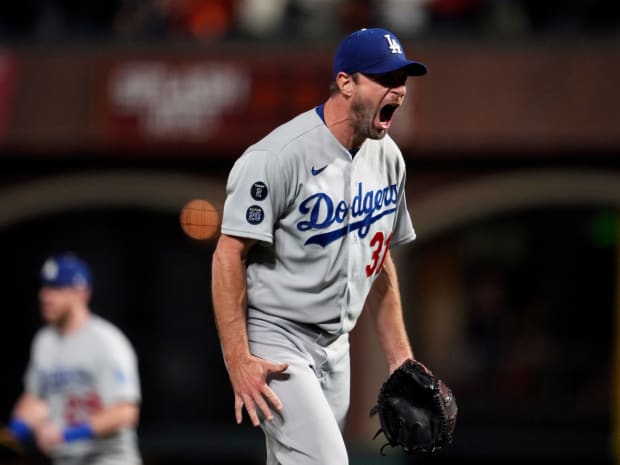As baseball remains shut down on economic issues, union executive director Tony Clark observed, “Players have been commoditized, monetized in a way that is really hard to explain.” He is right. Over the last CBA the game traded its soul, its humanism, for ruthless efficiency in which the guiding principle was not to entertain but to hack every incremental probability. Players were reduced to a metric, be it WAR or a luxury tax salary number, a cold diminution that does not happen in the NFL and NBA, where personality is allowed to flourish.
Baseball needs to return the game and its players to a more fan-friendly path. That is just another reason why these negotiations are so insulting to fans. Among items on the table, what is more important than how the game is played and how the World Series champion is decided? And yet these items are being commoditized, to borrow from Clark. The entertainment value needs more consideration.

Neville E. Guard/USA TODAY Sports
Behind strong objections from Max Scherzer, the union rejected a 14-team playoff proposal in favor of a 12-team format. It also did not agree to a pitch timer, larger bases and a ban on shifts because it views on-field changes as bargaining chips, even though MLB will implement those changes for the 2023 season (with robo-strike zone coming in 2024).
When Scherzer called the 14-team proposal a red line that could not be crossed, owners backed down. He worried that it did not reward division winners enough. But the 12-team format is not a done deal. A source familiar with the talks indicated the union could still be convinced the 14-team format is the better way forward. The owners need to do a better job of presenting its benefits.
Every player like Scherzer goes to camp with the same goal: win the division. But it’s not 1969 anymore. The modern fan who grew up with March Madness loves the postseason and its randomness. You need to build a postseason format based on modern sensibilities, not a player’s narrow competitive prism.
The players have spitballed 12-team formats. In one offer they proposed splitting the leagues in two divisions, one with eight teams and one with seven. In another, they proposed giving a division winner a “ghost win” in a playoff series against a wild card team—starting a series up 1–0. Come on. Plenty of fans didn’t like the “ghost runner” extra-inning rule. Now you’re going to hand over an entire game—in the postseason, no less? No.
In the most recent proposal (again, nothing has been signed off), the top two division winners would get a bye, the third division winner plays the third wild card, and the No. 1 and No. 2 wild cards play each other. No details yet on whether these series include a change of venues. Put one travel day in and you start to penalize the top two division winners by making them wait too long. And the last thing anybody wants is more days without potential clinchers (the win-or-go-home games) in the postseason inventory.
The players argue this format rewards division winners less and lowers the bar too far to playoff qualification. Those are outdated views. The NFL, for instance, just cut the number of division winners in each conference that get byes, from two to one, while adding one playoff team in the AFC and one in the NFC. Why? Fans love postseason games. (It’s amazing how much more nimble and responsive other sports can be than baseball.) The idea was an immediate hit. The so-called Super Wild-Card Weekend averaged 30.5 million viewers, up 21%.
Moreover, division titles are not created equal, so stop acting like it. Last season, for instance, the AL Central champion White Sox played 56 games against winning teams while the AL East third-place Yankees played 91 games against winning teams.
Sign up to get the Five-Tool Newsletter in your inbox every week during the MLB offseason.
The players turned down a 14-team format that is better for them and the fans. It could and should come back to the table. Let’s count the ways it makes sense:
• The team with the best record in the league gets a bye, which keeps the top teams playing hard down the stretch even if they have a division locked up.
• The other two division winners and the No. 1 wild card host a best-of-three wild-card series entirely at home. That’s rewarding division winners and a high-win wild-card team such as the 2021 Dodgers (106 wins), ’18 Yankees (100), ’01 A’s (102), ’02 Angels (99) and ’04 Red Sox (98).
• The No. 2 seed—the second-best record among division winners—gets to pick its opponent among the three lowest wild-card teams. The No. 3 seed (the third division winner) then picks from the remaining two wild-card teams.
These choices are made on a Selection Show on the Sunday night after the final regular-season games are played. It’s one reason why ESPN agreed to pay $100 million for the 14-team format (and $85 million for the 12-team format). Your TV partner is telling you the Selection Show has real value, which means it believes fans want to see it.

Erick W. Rasco/Sports Illustrated
Just imagine this scenario. Dodgers president Andrew Friedman must step up to a microphone and declare who he will play among the Mets, Cardinals and Padres. The Mets are the lowest seed, but Friedman wants no part of seeing Scherzer and Jacob deGrom in a three-game series, even if all games are at Dodger Stadium. He picks the Cardinals. St. Louis fans are insulted. The series has immediate buzz from bulletin-board material before a game has been played.
• More games matter down the stretch. Teams must play out the schedule because of jockeying for the top seeds and the bottom seeds. MLB ran the research on this and quantified what it would mean for regional sports network ratings and attendance when more games matter in August and September. Yes, the bar for wins is lower—the Phillies would have qualified last year with 82 wins—but that means more teams are trying to win.
• Less tanking. Teams such as the Cubs and Astros punted five years to win a World Series. Good luck to a team president who tries to tell his fan base he can’t win 82 games for five consecutive years. When the playoffs are closer, the tanking is harder to sell.
• Less dumping. The Cubs and Nationals do not dump their best players at the trade deadline as they did last year if they know 82 wins could get them in the postseason.
• Less carcass-picking. Too many times a division title is decided by games after the deadline against teams that quit. The Braves went 7–2 against the Nationals once Washington dumped Scherzer, Trea Turner, et al. The Brewers went 6–1 against the Cubs after Chicago dumped Kris Bryant, Anthony Rizzo, et al.
• More money to players. A club president pointed this out to me. Front offices only partly build their teams in the offseason. They know they can find what they need at the trade deadline as teams fall out of the race (see the 2021 Braves). But that does not help player value. All you’re doing is exchanging which team is picking up the player’s check.
In a 14-team format, the delayed roster construction tactic is heavily diminished. With more teams in the race, there are fewer players available at the deadline. That means rosters need to be more fully built before the season, which means more competition for players—especially the veterans that are the missing pieces for good teams—which means more bidding and more money on mid-level free agents.
• More win-or-go-home games. You get a maximum of 12 potential first-round clinchers, up from eight in the 12-team format’s first round.
• More players in the postseason. Another 52 players get a chance to play postseason baseball. Hey, maybe even Mike Trout could be one of them.
• More fun. Hey, wouldn’t it be great if somebody at the negotiating table talked about making the game more fun—and not as a bargaining chip to trade for CBT thresholds and bonus pools? Is the Selection Show a gimmick? Call it what you want, but it’s already been determined to be an asset of value that’s been sold. It’s different. It’s fun. It’s modern. Both sides like to talk about “growing the game.” Prove it.







